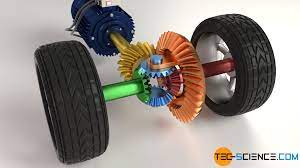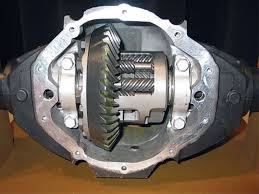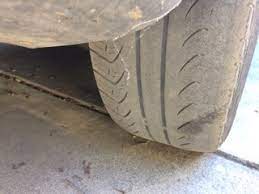Symptoms of a Bad Differential & How Much it Costs to Fix
In this article we are going to be looking at the differential, an aspect of our cars that many of us do not truly understand. We will look at the symptoms of a bad differential, how to fix them and how much this might cost us.
What Is the Differential?
The best place to start as always is by understanding the parts of the car that we think may not be working correctly. In this case it is the differential, a very important component when it comes to turning corners.
When we take a corner the right and left wheels take different paths with the inside wheels having a smaller turning radius. This means that those inside wheels need to rotate fewer times than the wheels on the outside of the turn. So if you are turning left then the wheels on the left of your car will rotate less than the ones on the right.

The differential is what allows for this difference in wheel rotation. Without this both sides would rotate at the same speed and you would start to lose traction in the corner. You would also over time cause undue wear on the powertrain and your tires.
This all works based on something called track width, which is a measurement of the distance between the left and right tires. As the track width grows the turn becomes tighter and the speed difference between the two sides increases.
Where Is the Differential?
There can be some variation when it comes to differential location and it will depend greatly on your model of car. If you have a two-wheel drive vehicle you will only have one differential but if you have all-wheel drive there will be three. Some four-wheel drive model cars will have a differential on each axle and a transfer case instead of the third central differential.

No matter how many differentials you have they will tend to be located under the car and will be placed centrally between the wheels or axles they will be working on. It is always a good idea to refer to your owner's manual when you are trying to locate parts like the differential.
Signs of a Bad Differential
There are a few important symptoms of a failing differential that you should look out for. The part may start to fail gradually so hopefully you will get fair warning of the issue before it becomes a dangerous situation.
Whining Sound
One of the most common signs your differential is struggling is a whining sound and this might just mean that its components are not properly lubricated. This may indicate you have a fluid leak which needs to be addressed in order to get the system back up and running correctly.
The more lubrication that the differential loses the louder the whining will become. If you leave this unresolved for too long you may cause even more damage turning a potential repair into a replacement which will cost you more money.
Tire Wear Issues
When everything is fine with the wheels and the operation of the differential then tire wear should be more or less even. You should see little difference between the two sides of the vehicle and you certainly should not see one edge of the tire being balder than the other.

When the differential is not working correctly the car's inner tires when turning will see more stress and wear out more quickly. This is because they are not slowing down in the turns. It is a common symptom of differential issues to see uneven tire wear.
If your differential has locked up you may also hear a chirping or rapid squealing sound from your tires. This is called tire scrubbing and it indicates that the tires are slipping and finding grip intermittently. You may feel vibrations from this as well.
Poor Handling
As mentioned if the differential is not doing its job in the corners you commonly find that wheels will slip and you lose traction. This could be on a completely dry road with no logical reason for traction issues.
Obviously this will make your car more difficult to handle in corners. If weather conditions are also bad then this combination can be very dangerous and can lead to an accident
Vibrations
Once your differential or universal joints start to become worn out you will start to feel vibrations as you drive along. This is coming from the driveshaft and will usually happen when you accelerate. The vibrations will become worse if there is also a fluid leak from the differential.
This is one of the earliest signs you will receive warning of a potential problem so it is important to take note of that. The earlier you can diagnose an issue the more quickly you can get it repaired and once again have a well balanced car.
Repairing the Differential
Depending on the issue affecting your differential there may be several repair options. This is good because you do not have to immediately think of replacing the part. The issues may be as simple as leaks which may just need a gasket replacement.
There are a number of seals involved in the differential all of which could potentially wear with age and start to leak. The important step is to reseal the system and refill with the appropriate fluids.
If your issue is bearing based you will have to replace any damaged bearings and this can take a long time. It is tricky and often requires a mechanic or at least an advanced level of personal mechanic experience in order to do correctly.
Issues with the differential gears may also require replacement of the internal parts. This will take a lot of time and it will not be cheap. Replacing parts of the differential however will always be much cheaper than a whole new set up so if you can fix it then do so.
How Much Is a Differential Replacement?
If you can repair the differential you will pay on average somewhere between $200 - $400 depending on how extensive the damage is. If you need a rebuild of the differential this may run you between $400 - $1000 which again is not cheap.
Replacing the unit all together however can cost a lot. In fact on average you are easily looking at between $1000 - $2000 depending on your model. It is a complicated process so in all likelihood you will need a trained technician.
Conclusion
The differential helps maintain the balance between the left and right drive wheels as we take corners. They have to rotate at different speeds to take the turn smoothly and the differential allows them to do so without loss of traction.
This is an expensive part to repair but is also very expensive to replace. If you get early warning signs of a bad differential you need to get this fixed right away or your costs may quickly increase if the issue gets worse.
Link To or Reference This Page
We spend a lot of time collecting, cleaning, merging, and formatting the data that is shown on the site to be as useful to you as possible.
If you found the data or information on this page useful in your research, please use the tool below to properly cite or reference Tow Ratings as the source. We appreciate your support!
-
<a href="http://towratings.net/blog/symptoms-of-a-bad-differential-how-much-it-costs-to-fix/">Symptoms of a Bad Differential & How Much it Costs to Fix</a>
-
"Symptoms of a Bad Differential & How Much it Costs to Fix". Tow Ratings. Accessed on April 24, 2024. http://towratings.net/blog/symptoms-of-a-bad-differential-how-much-it-costs-to-fix/.
-
"Symptoms of a Bad Differential & How Much it Costs to Fix". Tow Ratings, http://towratings.net/blog/symptoms-of-a-bad-differential-how-much-it-costs-to-fix/. Accessed 24 April, 2024
-
Symptoms of a Bad Differential & How Much it Costs to Fix. Tow Ratings. Retrieved from http://towratings.net/blog/symptoms-of-a-bad-differential-how-much-it-costs-to-fix/.